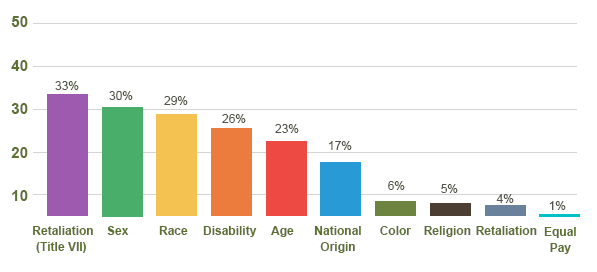The list of illegal types of discrimination is a long one. For example, an employment discrimination claim can be based on discrimination due to age, disability, race, religion, national origin, sex, or another characteristic – or a combination of two or more of these.
Both the federal government and the states have laws that govern discrimination claims in the workplace. An employee who believes he or she has been the target of workplace discrimination that violates the law may benefit from consulting an experienced New York employment discrimination lawyer.
Which types of employment discrimination claims are most common in New York? Based on the Equal Employment Opportunity Commission (EEOC) data, below is the “top ten” list for the past five years, ranked according to the percentage of claims that involve each type of allegation. The total exceeds 100 percent because individuals may allege several kinds of discrimination in a single claim.

- Retaliation (Title VII): 33 percent. This type of retaliation occurs when an employer takes a negative action against an employee who acts as a whistleblower or who files an employment discrimination claim. Employers may not retaliate even if the EEOC finds that no discrimination occurred. Retaliation includes negative acts taken in terms of hiring or firing, pay, job assignments, promotions, layoffs, training, fringe benefits and any other “term or condition” of employment.

- Sex: 30 percent. Sex discrimination claims involve treating an applicant or employee unfavorably because of that person’s sex, whether male or female. It includes discrimination against transgender individuals, as well as sexual harassment.

- Race: 29 percent. Racial discrimination covers situations in which people are treated unfavorably because they are of a certain race or look as if they belong to a certain race. Like other types of discrimination, harassment due to racial group or characteristics is prohibited.

- Disability: 26 percent. Discrimination on the basis of disability may occur when a person covered by the Americans with Disabilities Act (ADA) or Rehabilitation Act is treated unfavorably or harassed at work due to the person’s disability. It also covers claims in which a person is treated unfavorably at work because a family member has a disability.

- Age: 23 percent. The Age Discrimination in Employment Act (ADEA) prohibits employers from discriminating against workers based on age. It offers specific protections to workers over the age of 40 with regards to hiring, discharging, compensation, terms, privileges and other matters.

- National origin: 17 percent. Prohibited types of discrimination based on national origin include unfavorable treatment based on coming from a particular country or part of the world, being of a certain ethnicity or having an accent. It also covers discrimination in situations in which an employer treats an employee unfavorably because the employee is believed to be of a certain national origin, even if he or she is not actually from that place.

- Color: 6 percent. Although claims based on illegal race discrimination and claims based on illegal color discrimination are often related, the two categories can also be distinguished. Color discrimination focuses on unfavorable treatment due to a particular skin color or complexion.

- Religion: 5 percent. Religious discrimination occurs when an employee is treated unfavorably because of his or her religious beliefs. This includes not only beliefs belonging to organized religions, but also to other sincerely held religious and ethical or moral beliefs. Treating an employee unfavorably because he or she is married to or associated with a person with a particular religious belief is also prohibited.

- Retaliation (other): 4 percent. While most retaliation claims are based on employment discrimination lawsuits filed under Title VII of the Civil Rights Act, some retaliation claims are based on employment discrimination lawsuits filed under other laws, such as the Americans with Disabilities Act or the Age Discrimination in Employment Act.

- Equal Pay: 1 percent. Violations of the Equal Pay Act occur when a man or woman is paid less than a member of the opposite sex for the same work. Because equal pay claims often involve sex discrimination, many people who have a claim under the Equal Pay Act also have a claim under Title VII of the Civil Rights Act for sex discrimination.

If you suspect you’ve suffered the effects of illegal employment discrimination on any grounds, you should discuss your situation with a qualified employment attorney such as the ones at the Law Office of Cohen & Jaffe, LLP on Long Island. You may be entitled to monetary compensation if you have been the victim of discrimination in the workplace in New York.









